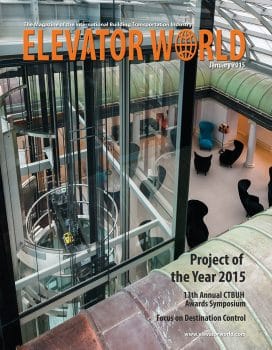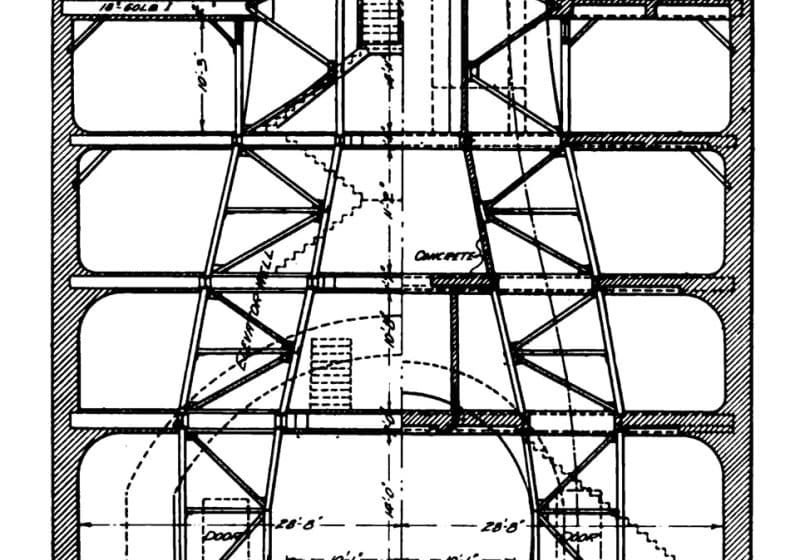Academic papers examine an industry in flux, serve as a reminder to be prepared.
Since renovation of the Technische Akademie Heilbronn (TAH) was ongoing, the Heilbronn European Lift Congress 2014 was held at the Maritim Hotel in Stuttgart, Germany, on October 7-8. More than 120 delegates attended, coming from all over Europe. This was the sixth congress, an “open to all” event with tremendous potential to further lift and escalator-system knowledge, component design and related technologies. The event also provided a great opportunity to consider code developments and improve awareness of related standards.
The event takes place under the umbrella of TAH, so it has always had an academic element. Organizers consistently ensure a good array of papers, so anyone interested in the world of vertical transportation may count on relevant presentations. A visit to an industrial/technology plant has also been a traditional part of the congress, giving delegates an opportunity to see what other industries and sectors are doing. This year, it was to the testing facility at the University of Stuttgart, adjacent to the Maritim Hotel. This proved very informative, and the delegates enjoyed being shown around the impressive test hall.
There were 16 presentations at the main conference. Areas covered included new regulations, sustainability and technical innovation. The papers were presented by experienced lift professionals, including association officers, university professors and senior R&D engineers.
Day One
Philippe Lamalle, European Lift Association (ELA) president, opened the congress with a thought-provoking presentation, “Lifts for the Future of Europe.” In it, forecasts were made about the aging and growing European population. Projections suggest a majority of the population will live in urban areas, and more than 30% will be older than 60 by 2050. This situation would create many challenges for the lift and escalator industry.
Lamalle explained the scope of ELA and how it is gathering data and statistics regarding the use and safety of installations all over Europe. He reaffirmed topics introduced at the ELA 2013 Congress in Amsterdam, The Netherlands, where the phrase “The Lift at the Heart of the Building” was used as the title of the keynote address. In closing, Lamalle stressed the importance of the 2014-17 Road Map, which sets out the vision and scope of ELA over those years.
Veronique Spreadbury then considered product liability and traceability according to the new Lifts Directive. She pointed out the original directive was started 20 years ago, so it was significant that a recast was needed to reflect product development and align the amendments to the new legislative framework. Hearing the presentation, it was clear that much work is still needed regarding what companies must have in place by early 2016. Companies will have to work productively with the European Commission (EC) to ensure relevant existing reporting/surveillance systems and the new infrastructure required is in place and workable.
Dr. Ana Maria Lorente-Lafuente then offered a very informative presentation looking at energy performance of lifts according to ISO 25745-2. Lorente-Lafuente considered the work carried out by the task force and explained why the standard looks as it does today. In her concluding remarks, she observed:
“The simulations conducted for the development of the standard revealed the need to consider the characteristics of the building in which a lift will be installed to obtain the main parameters used in the equations. If the characteristics of the building population are known (type of building, occupancy per floor, traffic pattern, etc.), it is recommended to use data from measurements or simulation tools for a more accurate prediction of the energy to be consumed by the installation, but where this is not possible, ISO 25745-2 gives an easy-to-use but fair, common and accurate method to compare products, with a very reasonable level of uncertainty, considering the complexity of the problem.”
Nikolay Minkov’s presentation considered the method of life cycle assessment, Type III environmental declarations developed according to ISO 14025 to provide transparent and quantitative information about a product’s environmental impact. Attendees were informed the lift industry started the elaboration of such product category rules (PCRs) for lifts in May 2013.
To summarize this presentation, it was stated that:
“Developing globally applicable PCRs is an extremely challenging task. However, the lift industry has undertaken a long, but practical and fruitful, transition, leaving the unfair practices of green-washing by moving toward a fair and transparent approach of communicating the environmental impacts of its products. The PCR development process has already put on the table a variety of industry representatives – lift manufacturers, component producers, academics and consultants. The preparation of PCRs for lifts is a crucial and time-consuming effort. The need for extending the current development process is clear, and, once fair rules are agreed [upon] and equally implemented by all, it will be beneficial for society and the environment.”
Dirk Preissi explained the opposition sessions to the new EN 81-72, which ran in February 2014, so a new release is expected soon. There were many expected changes to version 2003, including:
- Negotiations among the owner, customer, building designers, fire authorities and installers regarding detailed planning
- Environment and building requirements, including water management, power supply and smoke control
- Fundamental firefighter lift requirements, such as protecting electrical equipment from water, rescuing firefighters trapped in lifts and maintaining control systems
Ashiqur Rahman introduced the floor warden (FW) as a new concept for evacuating building occupants using lifts. In essence, it involves a floor warden controlling a lift from the landing that needs to be evacuated. Obviously, this requires a secure and fully integrated intercom system, so the FW can always hear what is going on in the cab. “We hope that this concept will help bring forward the discussion about the application of lifts in case of an emergency,” Rahman said. “In the end, bringing occupants out of a building safely is the goal that the lift industry should aim at.”
Petteri Valjus gave a simple overview of KONE UltraRopeTM, illustrated by a number of UltraRope installations. He explained that carbon fiber was chosen for the material, as it is well understood and available, whereas the practical development of nanomaterials is still too far away to be a commercially viable.
Sven Winter introduced the topic of rope research at the Institute of Mechanical Handling and Logistics at the University of Stuttgart. Winter showed the delegates destructive rope-testing procedures up to 2500 kN and dynamic load and bending fatigue tests up to 500 kN rope force. Following these destructive tests, Winter went on to illustrate non-destructive rope testing, which was very informative. The team demonstrated the use of magnetic inspection and the portable equipment they use to inspect and evaluate the large steel rope used on bridges, ropeways, cranes and elevators.
The last part of the paper related to the R&D of a new rope rotation sensor. By using a 3D acceleration sensor, rope rotation can be measured within operation at any section of the rope. The results are related to support elements and characteristics of the installation afterward. For the first time, it will be possible to measure alignment quality and determine combined factors that cause damaging rope rotation. Attendees were then invited to visit the test lab just a few steps away, and everyone gratefully accepted the opportunity.
Day Two
Dr. Stefan Kaczmarczyk started the presentations with a very important topic, “The Prediction and Analysis of Dynamic Behavior and Vibrations of Lift Systems.” This paper demonstrated a general approach to model the dynamic behavior of typical lift installations. Subsequently, vibration modeling and simulation techniques for the prediction of their dynamic responses were explained, and strategies were shown that can minimize adverse effects. As readers can imagine, Kaczmarczyk’s presentation was very well structured and presented, making it accessible to the audience, regardless of an understanding of mathematics and calculations.
Dr. Etienne Nitidem then presented his paper, which was well placed in the program, as Kaczmarczyk had given the delegates an understanding of the subject. Nitidem’s paper was “Modeling and Simulation of the Dynamic Behavior of Lift Systems with Cantilever Car Slings.” This was a very practical paper, and presented methodologies and an example of how to combine the advantages of a cantilever car sling design with the efficiency and performance of an intelligent drive system. Nitidem was able to show why the electrical drive is one of the most important excitation sources and how vibration isolation can be actively and passively done.
Peter Herkel’s paper was first presented at Elevcon Paris 2014 (ELEVATOR WORLD, October 2014). The paper, “System Analysis and Architecture Methodologies to Drive Innovative Electrical Systems,” was published in Elevator Technology 20, Proceedings of Elevcon 2014 from the International Association of Elevator Engineers (IAEE). Herkel’s conclusion sums it up well:
“By proper use of system analysis and architecture methodologies, innovative electrical system design that meets and exceeds customer expectations can be achieved. Based upon the challenges being addressed, there are often fundamentally different solutions required. This has been shown in several case studies, ranging from super high-rise; low-rise, and machine-room-less [systems]; and battery-powered elevators. By continuing to use these analyses and architecture methodologies, future requirements, constraints and customer needs will continue to be successfully addressed.”
Carl van den Einden presented an interesting overview on service lifts in wind turbines. It was clear from the presentation the height and dynamics of these structures make lifts essential for access and maintenance. The nature of the structures makes the design and code requirements very exacting, with many elements to take into consideration. It is difficult to know where this type of service equipment should fit. However, the members of TC 10 decided the standard for this type of service lift should be part of the EN 81 lift family.
van den Einden stated stakeholders have requested a harmonized standard for these types of lifts. This has been accepted by the EC, and a mandate has been given to the European Committee for Standardization (CEN). A working group has been formed within CEN to develop the standard, which will be EN 81-44. This paper was also first presented at Elevcon Paris 2014 and published in the aforementioned book of papers.
Esfandiar Gharibaan, Ian Jones, Gerhard Schiffner and Ari Kattainen gave a major presentation entitled “Codes, Standards and Principles of EN 81-20/50.” They covered, in depth, the background to the document and how that related to the mechanical and electrical equipment used and designed by the lift sector. The abstract to this session sums up this presentation well:
“The new EN 81-20 and EN 81-50, which will replace the previous basic parts of EN 81-1 and EN 81-2, will have an essential impact on lift and component manufacturers due to the enormous effort needed for applying the numerous modifications to their products. This report is intended to inform all stakeholders on the final content of the new standards and on the further roadmap for their application. Details are provided to explain the differences compared with the previous versions and consequences for components and systems.”
The individual presentations were followed by a panel session during which delegates could ask questions of the CEN/TC 10 experts to help address individual concerns. Everyone was encouraged to study the papers presented in the book along with any other advice and comments available from national associations and related bodies.
Georg Clauss closed the event by thanking the speakers and delegates and, in particular, the supporters – associations, trade press and all those who had taken time out of their busy schedules to attend. This concluded the congress, and delegates left for home having learned a great deal about the art and science of moving people through architectural space. However, they also realized there is a tremendous amount of work to be done to ensure new codes and standards are in place and understood.
Get more of Elevator World. Sign up for our free e-newsletter.










